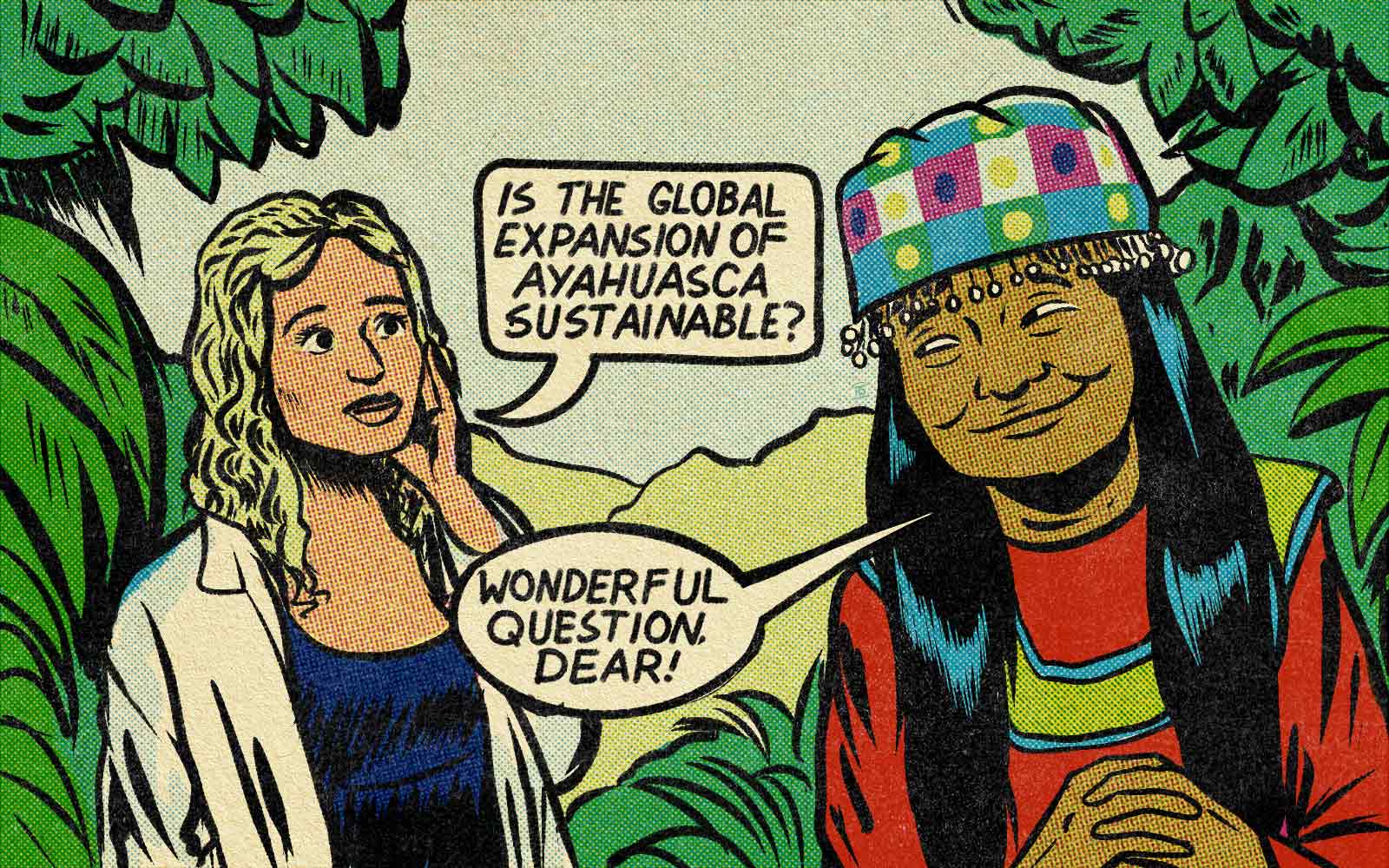As plant medicines have garnered new interest during this psychedelic renaissance, those wishing to experience the benefits have graduated from microdosing psilocybin or perhaps an experience with LSD or Kambo. Now, they are ready to take the gloves off and surrender to the teachings of maybe the greatest mother medicine of them all. Ayahuasca is not for the faint of heart, and those who choose to partake must be deeply committed to the process. From adhering to the ayahuasca dieta, to the time it takes to travel deep into the jungle and participate in the ceremony, one must be certain that they wish to commune with the plant teachers in such a profound way.
Science is beginning to speak to the health benefits ayahuasca may have on the mood, mind, and general outlook on life. Anecdotal reports are often likened to the sentiment that an evening with ayahuasca is like 10 years of therapy downloaded into one session. Yet, as ayahuasca use continues to rise, the question remains: is ayahuasca sustainable? Can this medicine continue to be produced at a rate that meets the growing demand? To fully understand the dynamics of this query, one must examine the life cycle of the plants used to make ayahuasca brew and consider the future of expansion of this plant teacher.
The Creation of Ayahuasca
Ayahuasca, also known as yajé, or yagé, is a tea or brew traditionally made with two different plants native to the Amazon. This powerful hallucinogenic has been used for centuries by the indigenous South Americans in the Amazon basin. Although the preparation and approach to consumption vary slightly by region and shaman, much of the practices share many commonalities.
The Plants
Banisteriopsis caapi, or B. caapi, is native to northern and western South America. It is the foundational ingredient in all ayahuasca brews. B. caapi is a vine that can grow up to 30 meters long, using other plants and trees for support as it turns into thick twists and knots. The B. caapi vine requires partial shade and moist soil. Heat and humidity are a must for optimum vine health, and it takes five years for B. caapi to fully mature.
Psychotria viridis, or P. viridis, is the second plant used to prepare ayahuasca brew. It is also known as ‘chacruna’. Native to the Amazonian lowlands, P. viridis is a large perennial shrub that grows in partial shade to full sun. It thrives well in wet, tropical rainforest climates, particularly in Peru and Bolivia. It grows to approximately five meters tall, with leaves conical in shape, growing opposite one another along the stem. P. viridis is ready to harvest within one to two years.
B. caapi and P. viridis both have hallucinogenic properties. P. viridis contains N,N-dimethyltryptamine (DMT) — an extremely potent psychedelic substance that can produce mild-altering visual hallucinations, out-of-body experiences, and heightened euphoria. However, it has a low bioavailability, meaning that the body quickly breaks it down into enzymes called monoamine oxidases (MAOs). Because of this, the DMT in P. viridis will not produce the effects commonly associated with ayahuasca on its own. It requires the monoamine oxidase inhibitors (MAOIs) called beta-carbolines found in B. caapi to produce its effects.
Brewing Ayahuasca
Brewing ayahuasca is a time-intensive ritual that requires skill, patience, and intention. While there are several methods of brewing, the basics involve a few main steps. First, the B. caapi vine is cleaned from any debris. Then, the vines are smashed and crushed until they break into smaller pieces. The intention is not to decimate the vine but to break it open to expose the medicine inside.
Next, the shaman tears the leaves of the P. viridis into small pieces and puts them into a pot with the smashed vine and covers the plant material with water. The pot is placed over a fire and brought to a boil. There is no standard brewing time, but the shaman will know when to remove the pot from the fire.
The entire process typically involves multiple “washes” where the water is removed, and more is added to the plants in the pot. The amount of reductions vary, but once all of the liquid has been collected, it is placed back into the pot without plant material for its final reduction. The goal is to reduce it down to a thick, dark liquid that is highly concentrated. After the final reduction, the brew is cooled before filtering to remove any remaining impurities or pieces of plant matter.
From Indigenous Ritual to Popular Plant Medicine
Indigenous use of ayahuasca is an ancient practice that is widely used throughout the Amazon for spiritual and religious purposes. Churches like Santo Daime and União de Vegetal, though founded in Brazil, have spread into North America and Europe, where they continue to drink ayahuasca under religious legal protection. That’s not to say it hasn’t come without scrutiny and continued legal battles. For this reason and others, many Westerners have descended into the Amazonian jungles to sit with the medicine.
Although thousands of people visit the epicenter of ayahuasca tourism in Iquitos, Peru every year, many are finding access to ayahuasca in North America. Since B. caapi and P. viridis do not naturally thrive in the U.S. — and are highly illegal — it’s not likely that the ceremonies performed in the U.S. are using homegrown ayahuasca. Rather, it is making its way from the Amazon, further depleting the supply available to the indigenous peoples. Or is it?
A Trip Into the Peruvian Jungle
In a 2018 article titled, “Field Report: Ayahuasca Vine Cultivation and Harvesting in the Peruvian Amazon”, author Chris Kilham describes a journey he took into the Peruvian jungle to meet with locals and investigate the sustainability of ayahuasca. Kilham notes that this research does not account for the many other locations where ayahuasca is popular — Brazil, Columbia, Ecuador, Costa Rica, Hawaii — and focuses on Peru’s Iquitos and Pucallpa regions. Kilham meets with many cultivators, curanderos, and shamans, detailing the cost and volume of brewing ayahuasca.
During his journey, he meets people claiming that they are feeling the scarcity of the precious vine B. caapi, and he meets others who say they have thousands of vines planted on their property. Some cultivators grow huambisa plants rather than chacruna. This DMT-containing plant is said to produce stronger visual hallucinations. Kilham writes that some people are merely growing their own supply to sustain their retreat centers, while others are growing to sell.
Kilham concludes that there isn’t sufficient evidence that the plants used to brew ayahuasca are endangered. However, he points out that his research is a snapshot of one region, and he cannot predict the growth cycle over the next five, 10, or 20 years.
What’s Next for Ayahuasca
Is it the precious plants themselves that need the most protection? Or maybe the sacred traditions of indigenous peoples that may be diluted by Western society? Perhaps a little of both. But consider the bigger picture. The truth is, while ayahuasca will hopefully remain a sacred ritual for all indigenous people, there are also plenty of other people who understand that it may become a lucrative business opportunity. And that will drive demand to numbers not yet predictable.
It’s unlikely that ayahuasca will be wholly eradicated from the earth. However, a much larger issue is at stake, which is the fact that the Amazon rainforest is facing massive devastation. Approximately 1.5 million acres of rainforest are cut down every year, and the rates are only climbing, especially throughout Peru. Access to ayahuasca is but one consideration amidst all of this deforestation.
There’s no doubt that ayahuasca holds power to radically change the lives of countless people. Its potent magic has already shifted reality for many by alleviating deep grief, trauma, despair and replacing it with purpose, clarity, and an immense appreciation for life. In the spirit of the global community, anyone who feels called to do this work should be able to access it. As far as the sustainability of ayahuasca, it will require a continual effort to preserve the Amazon and the traditions upheld by its indigenous cultures. After all, this devotion to finding a balance between humankind and nature is one of the greatest lessons ayahuasca aims to teach her students.
While it may seem like time moves slowly when it comes to ending prohibition for psychedelic substances, society is largely more accepting of the study of entheogenic plants for medicinal use. We hope that the evolution of psychedelic wellness embraces ayahuasca and focuses efforts towards the sustainability of ayahuasca for long-term use to heal our bodies, minds, and the planet.
If you have a unique perspective about this topic, please drop a thought in the comments below. We always love to hear from you.















